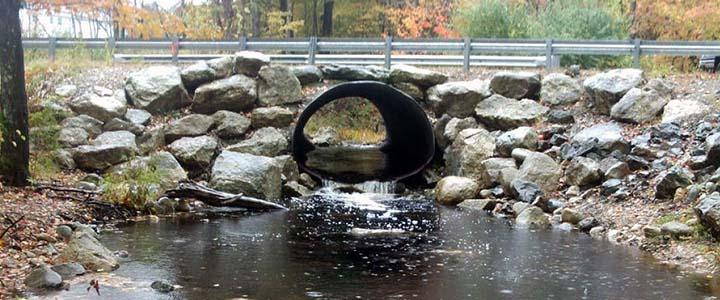
NHDES awards wetlands protection and stream enhancement grants
The NHDES Aquatic Resource Mitigation (ARM) Fund Program has awarded grants for seven projects in the Salmon Falls-Piscataqua River Service Area totaling $1,866,306.
The ARM Fund is an in-lieu fee option for projects impacting wetlands and streams that cannot avoid or minimize impacts, and are not able to provide other suitable forms of mitigation. An ARM Fund Site Selection Committee is charged with identifying proposals to be funded by selecting high-priority projects that most effectively compensate for the loss of functions and values from the projects that paid into the Fund. Projects determined to be appropriate for receipt of ARM Fund monies are subject to approval by the US Army Corps of Engineers and the New Hampshire Wetlands Council.
Projects
Champlin Forest Addition, Rochester – $110,000
The Society for the Protection of New Hampshire Forests will use ARM funds to permanently protect a 122-acre parcel of land be held by the Land and Community Heritage Investment Program. This parcel extends the existing 185-acre William H. Champlin, Jr. Forest in Rochester, NH, which will result in over 300 contiguous acres of protected forests and wetlands within a suburban area continually faced with development pressures. The property has high-value aquatic resources with 14 acres of forested and scrub-shrub wetland, and 3,350 linear feet along an intermittent stream that feeds the perennial waters of Clark Brook, which lies in a wellhead area. The project will protect 108 acres of forested upland on Gonic Hill, one of the highest points in Rochester, and will provide a substantial buffer to help secure the water quality of these wetlands and Clark Brook.
Chelsey Brook Culvert Replacement, Lee – $245,000
The Town of Lee will use ARM funds to replace a deficient culvert to enhance aquatic connectivity and fish passage of Chelsey Brook in Lee, NH. The current structure is significantly undersized for the stream width. The pipe impairs fish and wildlife passage, and inhibits natural water and sediment transport. The project site is located 1,000 feet upstream from the confluence with the Oyster River, a New Hampshire Designated River, and is the first crossing migratory fish encounter. The project will replace the seven-foot metal pipe with a 15-foot span and box culvert embedded with natural sediment to simulate the natural stream channel. Replacing this stream crossing will create continuous connectivity for the first 1.8 miles of Chelsey Brook and provide water velocities, depths and substrate transport consistent with the natural stream.
Jones Brook-Branch River Project, Milton – $475,000
The Southeast Land Trust of New Hampshire will use ARM funds to permanently protect roughly 563 acres of the Jones Brook-Branch River catchment area through a conservation easement. This property has diverse aquatic resources, which include approximately 123 acres of wetlands dispersed across 18 wetland units, 19 vernal pools, and 4.7 miles of streams. Most of the property (97%) is ranked high-quality habitat by the New Hampshire Fish and Game 2020 Wildlife Action Plan and a total of 51 wildlife species of New Hampshire Special Concern are documented on this property. This area has been identified in the Land Conservation Priorities of Coastal Resource (2021) as having the greatest pollutant attenuation due to high functioning buffers and the entire property is within the Somersworth Water Works Source Water Protection Area.
North Mill Pond, Portsmouth – $419,306
ARM funds will be used by the City of Portsmouth to restore a degraded tidal shoreline to improve water quality, wildlife habitat connectivity, and support marsh migration within North Mill Pond. The site is currently an abandoned industrial area overgrown with invasive plants and a highly eroded shoreline. The project will result in roughly 0.46 acres of wetlands enhancements and about 0.27 acres of wetland creation that will consist of rocky intertidal tide pool habitat, low marsh and high marsh areas. To address issues from the surrounding developed land, storm water will be captured by a combination of treatment devices, and material for an adjacent community park and walkway will use pervious surfaces.
Oyster River Restoration Topaz Drive Culvert Replacement, Barrington – $300,000
The Nature Conservancy will use ARM funds to fully restore aquatic fish and wildlife passage at a degraded stream crossing on the Oyster River in Barrington. The current culvert is too small for full stream flow, is perched by over one foot and is a complete barrier for all aquatic organisms. This project is a long-standing priority in the Salmon Falls-Piscataqua watershed to restore aquatic connectivity for several Species of Greatest Conservation Need in New Hampshire that occur in the vicinity, including American brook lamprey, American eel, brook trout, Blanding’s turtle and spotted turtle. The proposed stream crossing is a 30-foot wide, open-bottom steel bridge that will result in 5.2 miles of fully reconnected upstream habitat on the Oyster River.
Pike-Lamprey River, Durham – $220,000
ARM funds will be used by the Southeast Land Trust of New Hampshire to permanently conserve roughly 37.4 acres along the Lamprey River in Durham. 91% of the property is high-ranked habitat, and includes a diverse landscape, including horse pasture, forest, intermittent streams, wetlands and numerous vernal pools. All of the wetlands and streams on the property flow to the federally designated Wild and Scenic Lamprey River, which is also a NHDES Designated River.
Sam Plummer Road Stream Crossing, Milton – $97,000
The Strafford County Conservation District will use ARM funds to replace an undersized and deteriorating metal pipe culvert that conveys a perennial tributary to Lyman Brook in Milton, NH. The existing structure is undersized and vulnerable to flooding, and is a barrier to fish and wildlife passage. This project will replace the structure with an open-bottom span that can pass the 100-year peak flows and will be fully passable by all aquatic organisms. Replacing this barrier will regain headwater access to approximately 1.2 miles of excellent instream cold water habitat and benefit multiple aquatic species.




